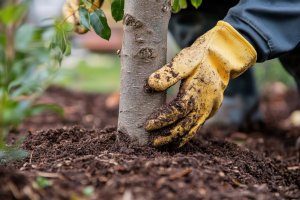Root pruning is a necessary yet risky process to minimize root damage before a construction project or prepare large trees for transplant. Yet, many homeowners also consider using root pruning to encourage healthy growth and reduce competition for nutrients between their plants.
When done incorrectly, root pruning can cause permanent root damage, negatively impacting the health and stability of the tree. However, in the right conditions and using the proper techniques, root pruning can safeguard the health of trees for years to come. This article provides an overview of root pruning, including tips for risk assessment, to clarify the benefits homeowners can expect from the professional root pruning process.
What is Root Pruning?

Poor root growth is a contributing problem to poor tree health when introducing new trees to a plot of land. Many nurseries prune tree roots to stimulate growth, though its effectiveness varies, especially with heavy pruning. In established trees, root pruning can help minimize damage to the root system during a construction project or transplant or help maintain healthy growth in the long term.
Provided the right techniques are used, root manipulation and pruning are effective methods for encouraging new root growth and aiding the tree’s longevity. Notably, severing roots will force the tree to focus resources on the severed area rather than on primary trunk and branch growth.
Conversely, root overgrowth can cause crowding, leading to unexpected decay when competition for water and nutrients between trees, turf, and other plants goes unchecked. Root pruning is a delicate task that must be handled correctly with expert guidance and correct methods.
How Do Experts Prune Tree Roots?
The tools and methods needed to properly prune tree roots depend on several factors, including the size of the roots. Smaller roots can be cut by hand while those greater than three inches in diameter should be avoided if possible.

For the smaller roots, hand tools such as small saws and loppers can be used while fine roots exposed during the pruning process can be sprayed and covered to prevent them from drying out. Professionals often use a specialized root pruner to make cleaner cuts, though it provides less precision in the location of the cuts compared to hand tools.
In some cases, especially in those involving construction projects, excavators or trenchers are used to lift roots so they can be pruned. However, this method often destroys surface roots and damages the ends. These can be pruned to mitigate further damage to the tree, but these heavier and less delicate methods should be avoided when possible.
The location of the roots is another important factor experts consider before root pruning. Roots should be cut a certain distance from the trunk to have a minimal impact on the stability and long-term health of the tree. For best results, roots should only be pruned outside of the tree’s dripline, which is the zone around the trunk that gets the most rainwater.
This distance depends on the circumference of the trunk and the nearness of other plants. Professional tree care experts can examine the trees on a property and identify the limitations and benefits of potential root pruning based on these factors.
Signs a Property Needs Root Pruning

When roots are properly maintained, trees can remain vibrant, well-nourished, and healthy. Though root pruning comes with risks, the risks of poorly maintained root systems are far greater, including lower resistance to diseases, pests, and weather damage and lower long-term sustainability.
These are the main signs to look for that root pruning could be an asset to the property:
- Root Curling or Circling: Visible roots curling on the soil’s surface can be a sign that the roots are overgrown.
- Stunted Trees: If the trees or surrounding plants are underperforming, their growth may be stunted by an overgrown root system.
- Sparse Turf or Foliage: Overgrown roots can cause competition for nutrients with nearby plants, resulting in patching or dying turf.
- Compacted Soil: Hard, compacted soil can be a result of overgrown roots that are not allowing the soil to lie naturally.
- Pooling Water: Compact soil caused by overgrown roots can prevent proper soil drainage.
- Property Damage: When root systems overgrow, they can damage foundations, walkways, and other structures.
Partner with Tree Care Experts to Maximize Tree Health with Root Pruning
Attempting to increase the stability of trees by pruning their root systems is a delicate process. Without the right tools and guidance, root pruning can permanently damage the trees and impact the sustainability of everything else on the property.
At RTEC Treecare, our goal is to safeguard the health and value of your property by customizing root and tree care plans for its specific needs. Our sustainability-focused approach to long-term tree care accounts for not only the trees but also the soil and surrounding foliage when recommending the optimum pruning process.
Contact our team of experts today to learn how our environmentally-conscious landscape management process can safeguard the beauty and value of your property for many years to come.


